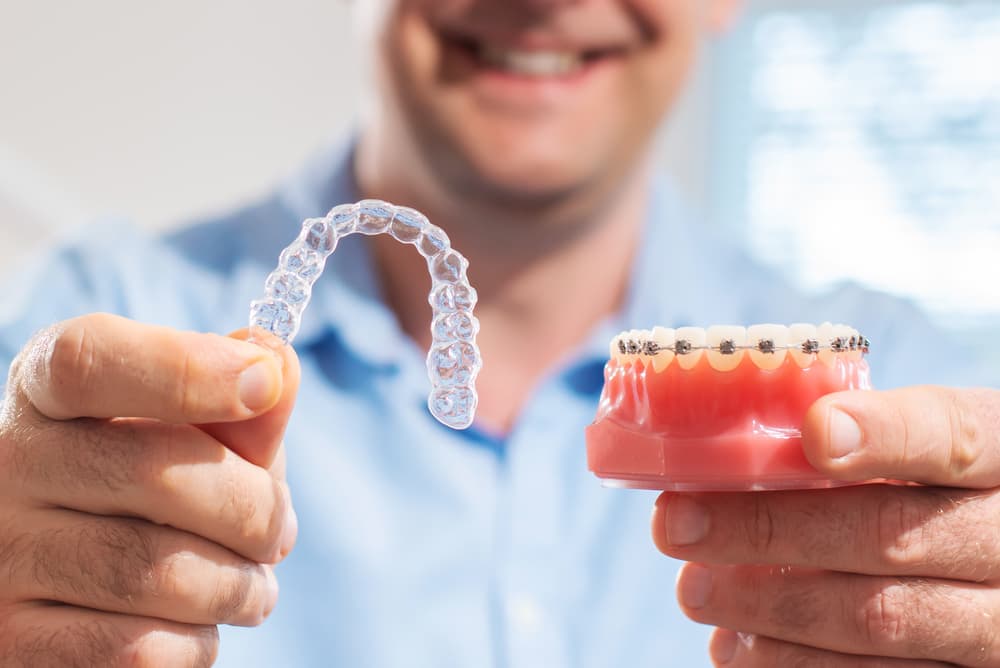
Many of us have, at some point, contemplated the need for orthodontic treatment to achieve that perfect smile. This might lead you to wonder which is best when it comes to braces vs. Invisalign. Whether it’s for aesthetic reasons or dental health concerns, making the right choice can be daunting. This blog aims to demystify the pros and cons of both options, providing you with the knowledge needed to make an informed decision. So, let’s dive in and help you embark on your journey to a straighter, healthier smile!
Contents
What are Braces?
Traditional braces are the favoured orthodontic choice for misaligned teeth and bite issues. Using bonding brackets, an archwire, and ligatures, they work by gradually shifting teeth into their desired position through continuous controlled pressure. Regular appointments are scheduled to tighten the spacing, encouraging the teeth to move over a set period. Let’s take a look at some of the benefits and drawbacks of this choice:
Pros
- Ideal for complex cases, braces can straighten even the most crooked of teeth.
- Since braces are fixed onto your teeth, they ensure continuous treatment progress.
- Traditional braces are often a cost-effective option that many health insurance plans cover.
Cons
- Following installation and after regular adjustments, braces can be uncomfortable.
- Braces are visually tricky to hide.
- During the time an individual has braces, their oral health routine will need to include meticulous cleaning, especially after eating.
What is Invisalign?
Invisalign is an alternative to traditional braces, using clear, removable aligners to straighten teeth and correct mild overbites gradually. These aligners are custom-made to your exact mouth specifications and exert a controlled and gentle pressure to shift the teeth slowly. A new set of aligners is created every one to two weeks to reflect the gradual movement happening. Similar to braces, Invisalign has its pros and cons:
Pros
- Due to their clear appearance, Invisalign trays are much more subtle than braces.
- Invisalign can be removed for eating, making oral health easier to maintain.
- Many patients maintain that Invisalign causes minimal discomfort.
Cons
- Invisalign tends to be more expensive than traditional braces.
- In the case of complex crowding or misalignment, Invisalign can be less effective.
- Trays must be worn between 20-22 hours a day to ensure proper treatment.
Which Option Is Right For Me?
Both braces and Invisalign can help straighten teeth, bringing you closer to a near-perfect smile. Since everyone’s teeth and alignment tend to be different, we recommend speaking with your orthodontist for helpful advice and insight into which option would be the best for you.
- For severe crowding and misalignment, braces are generally preferred. Since they have a single bracket adhered to every tooth, they are more capable of adjusting multiple crooked teeth simultaneously.
- On the other hand, Invisalign is ideal for less drastic alignment and bite issues. This option tends to be favoured by patients since it offers a subtle look and is an easier way to maintain oral health.
When deciding between braces vs. Invisalign, it’s crucial to speak with a dental professional. They possess specialized knowledge to assess your unique dental needs, alignment issues, and lifestyle. Their expertise ensures a tailored treatment plan, optimizing results and comfort.
Costello Family Dentistry is Here to Help
An orthodontist’s guidance leads to a healthier, more confident smile. If you’re considering both braces and Invisalign treatments, reach out to us at Costello Family Dentistry today. We’ll discuss which option is best depending on your alignment and bite and set up a dental treatment plan suited to your needs.



